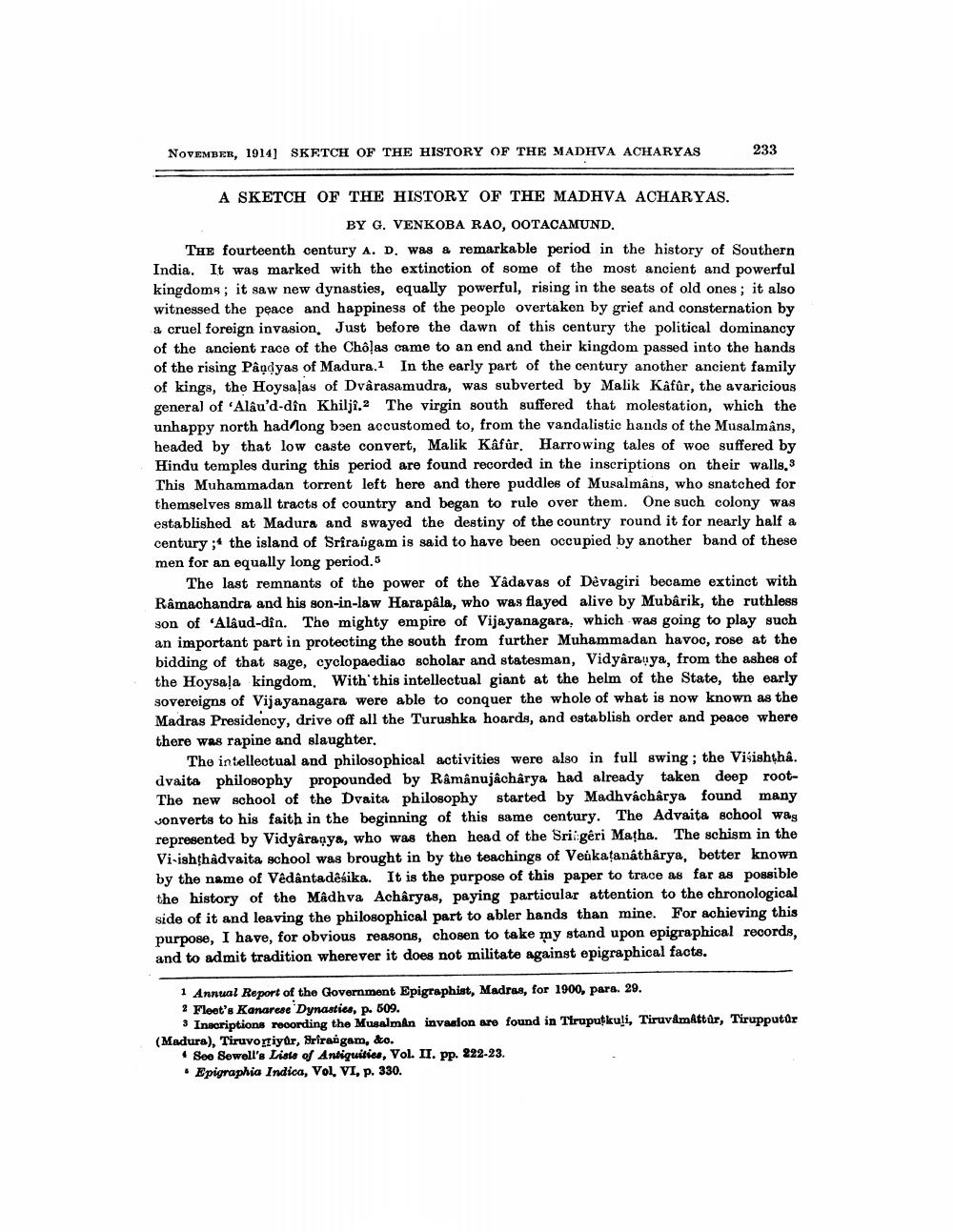________________
NOVEMBER, 1914) SKETCH OF THE HISTORY OF THE MADHVA ACHARYAS
233
A SKETCH OF THE HISTORY OF THE MADHVA ACHARYAS.
BY G. VENKOBA RAO, OOTACAMUND. The fourteenth century A. D. was & remarkable period in the history of Southern India. It was marked with the extinction of some of the most ancient and powerful kingdoms; it saw new dynasties, equally powerful, rising in the seats of old ones; it also witnessed the peace and happiness of the people overtaken by grief and consternation by a cruel foreign invasion. Just before the dawn of this century the political dominancy of the ancient race of the Chôļas came to an end and their kingdom passed into the hands of the rising Pâqdyas of Madura. In the early part of the century another ancient family of kings, the Hoysalas of Dvarasamudra, was subverted by Malik Kafûr, the avaricious general of 'Alau'd-din Khilji.2 The virgin south suffered that molestation, which the unhappy north had long buen accustomed to, from the vandalistic hands of the Musalmans, headed by that low caste convert, Malik Kâfûr. Harrowing tales of woe suffered by Hindu temples during this period are found recorded in the inscriptions on their walls, This Muhammadan torrent left here and there puddles of Musalmans, who snatched for themselves small tracts of country and began to rule over them. One such colony was established at Madura and swayed the destiny of the country round it for nearly half a century;the island of Sriraigam is said to have been occupied by another band of these men for an equally long period.5
The last remnants of the power of the Yadavas of Devagiri became extinct with Ramachandra and his son-in-law Harapala, who was flayed alive by Mubarik, the ruthless son of Alaud-din. The mighty empire of Vijayanagara, which was going to play such an important part in protecting the south from further Muhammadan havoc, rose at the bidding of that sage, cyclopaediac scholar and statesman, Vidyaranya, from the ashes of the Hoysala kingdom. With this intellectual giant at the helm of the State, the early sovereigns of Vijayanagara were able to conquer the whole of what is now known as the Madras Presidency, drive off all the Turushka hoards, and establish order and peace where there was rapine and slaughter.
The intellectual and philosophical activities were also in full swing; the Visishtha. dvaita philosophy propounded by Râmánujâcharya had already taken deep rootThe new school of the Dvaita philosophy started by Madhvacharya found many converts to his faith in the beginning of this same century. The Advaita school wag represented by Vidyâraqya, who was then head of the Sriigéri Matha. The schism in the Vi-ishthâdvaita school was brought in by the teachings of Veikatanátharya, better known by the name of Vedantadêsika. It is the purpose of this paper to trace as far as possible the history of the Madhva Acharyas, paying particular attention to the chronological side of it and leaving the philosophical part to abler hands than mine. For achieving this purpose, I have, for obvious reasons, chosen to take my stand upon epigraphical records, and to admit tradition wherever it does not militate against epigraphical facts.
1 Annual Report of the Government Epigraphist, Madras, for 1900, para. 29. 2 Fleet's Kanarese Dynasties, p. 509.
3 Inscriptions recording the Musalman invasion are found in Tiruputkuli, Tiruvam Attar, Tirupputur (Madura), Tiruvoriyur, Srirangam, &o.
• Seo Sowell's List of Antiquitica, Vol. II. Pp. 222-23. • Epigraphia Indica, Vol. VI, p. 330.




